Intrigued In Discovering Exactly How Site Style Has Changed Over The Years? Discover The Development From Fundamental, Straightforward Layouts To User-Centered Methods That Focus On The Requirements And Preferences Of Online Visitors
Intrigued In Discovering Exactly How Site Style Has Changed Over The Years? Discover The Development From Fundamental, Straightforward Layouts To User-Centered Methods That Focus On The Requirements And Preferences Of Online Visitors
Blog Article
Short Article Developed By-Carstens Gibbons
In the past, internet sites were basic and concentrated on information. Navigation was direct, and layout was for desktops. Currently, Read Full Report is key. Information guides designs for easy navigating. Receptive layouts fit different gadgets. Today, dark mode minimizes strain, and minimal food selections boost navigating. Interactive functions engage individuals, and strong visuals stand apart. AI combination improves engagement. See how design has actually evolved to improve your online trip.
Early Days of Web Design
In the very early days of website design, simplicity preponderated. Websites were standard, with restricted colors, font styles, and formats. The emphasis got on giving details rather than fancy visuals. Individuals accessed the internet via sluggish dial-up connections, so rate and capability were key.
Navigating menus were straightforward, generally located on top or side of the web page. Web sites were made for desktop, as mobile browsing had not been yet widespread. Content was king, and designers prioritized easy readability over complicated design elements.
HTML was the primary coding language made use of, and developers had to function within its constraints. https://www.entrepreneur.com/article/403982 and interactive attributes were minimal contrasted to today's standards. Websites were fixed, with little vibrant web content or individualized user experiences.
Increase of User-Focused Design
With the evolution of web site design, a shift in the direction of user-focused layout principles has actually ended up being significantly famous. Today, producing internet sites that prioritize user experience is crucial for involving site visitors and accomplishing service objectives. User-focused style includes comprehending the needs, choices, and actions of your target audience to tailor the site's design, content, and features as necessary.
Developers currently conduct detailed research, such as individual surveys and usability screening, to collect understandings and comments straight from users. This data-driven method helps in producing user-friendly navigation, clear calls-to-action, and aesthetically appealing interfaces that resonate with site visitors. By positioning the individual at the center of the layout process, sites can supply a more personalized and delightful experience.
Receptive style has actually likewise emerged as a vital element of user-focused design, making certain that web sites are enhanced for various gadgets and display dimensions. This flexibility boosts access and usability, satisfying the diverse methods users communicate with web sites today. In essence, the surge of user-focused design indicates a shift in the direction of creating electronic experiences that focus on the demands and expectations of the end user.
Modern Trends in Web Design
Explore the most recent trends forming website design today. One prominent fad is dark setting layout, offering a smooth and modern appearance while decreasing eye strain in low-light environments. Another crucial trend is minimal navigating, simplifying menus and boosting individual experience by focusing on essential elements. Integrating micro-interactions, such as animated buttons or scrolling effects, can create an extra interesting and interactive internet site. Receptive design continues to be crucial, making certain smooth individual experiences across numerous gadgets. In addition, using vibrant typography and unbalanced formats can add aesthetic rate of interest and accentuate certain web content.
Integrating AI technology, like chatbots for consumer support or customized suggestions, boosts user engagement and streamlines processes. Accessibility has also become a significant trend, with designers focusing on inclusive layout techniques to cater to varied individual needs. Welcoming sustainability by maximizing internet site performance for rate and performance is an additional emerging trend in web design. Working together with individual feedback and information analytics to iterate and enhance style continually is necessary for staying appropriate in the ever-evolving electronic landscape. By embracing these modern-day trends, you can create an aesthetically appealing, straightforward web site that reverberates with your audience.
a knockout post
As you reflect on the development of internet site layout from the early days to currently, you can see exactly how user-focused style has actually become the driving pressure behind modern-day trends.
Welcome the journey of adjustment and adaptation in website design, constantly maintaining the customer experience at the forefront.
Keep existing with the most recent patterns and modern technologies, and never quit evolving your technique to produce visually stunning and user-friendly internet sites.
Develop, adapt, and produce - the future of web design is in your hands.
